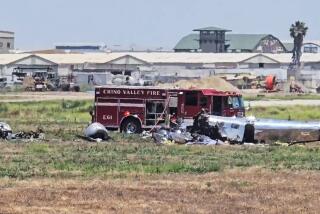U.S. Dismantling Navy Spy Plane on Chinese Island
- Share via
BEIJING — American technicians have made progress in dismantling a crippled Navy surveillance plane and have removed its tail cone in preparation for flying the aircraft home from China’s Hainan island, according to U.S. contractors.
The aircraft has been stranded on Hainan since it made an emergency landing there April 1 after colliding with a Chinese fighter jet over the South China Sea.
Photographs released by Lockheed Martin Aeronautics Co., which was contracted by the Defense Department to disassemble the EP-3, show cranes lifting its tail cone from the fuselage Friday.
The collision has topped a long list of Sino-U.S. disputes this year. But Chinese officials have said that they consider the incident essentially over and that they want to see ties with Washington return to normal.
After the collision, China detained the crew’s 24 members for 11 days. It also said that the Chinese fighter’s pilot, Wang Wei, had been killed, and it proclaimed him a “revolutionary martyr.”
Chinese officials refused to let the U.S. plane be repaired and flown out or removed by U.S. planes, saying that any further flights of U.S. military aircraft through Chinese airspace would provoke a public outcry. Nor did they want U.S. military personnel on the Lingshui military air base, where the plane has remained.
As a solution, the U.S. and China agreed to put the dismantled EP-3 on a commercial cargo plane for removal. On June 16, a Russian craft contracted from the Voronezh, Russia-based Polyot Air Cargo Co. landed at Lingshui to undertake that mission.
The Antonov 124-100 Ruslan is the world’s largest production airplane, has 24 wheels and can carry a payload of more than 330,000 pounds, with enough space to accommodate 50 automobiles.
The U.S. technicians first emptied the EP-3 of fuel, oil and hydraulic fluid and began building shipping crates to hold the aircraft. The crew will also remove the plane’s engines, antennas, propellers and wings.
Cranes will load the plane’s pieces onto the cargo craft and ship them in two batches to Kadena Air Base in Japan, where the EP-3’s flight began. Pentagon officials expect the mission to be completed by July 11.
More to Read
Sign up for Essential California
The most important California stories and recommendations in your inbox every morning.
You may occasionally receive promotional content from the Los Angeles Times.













